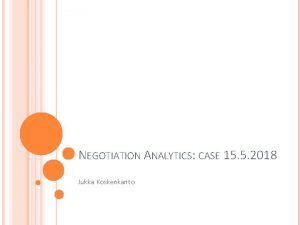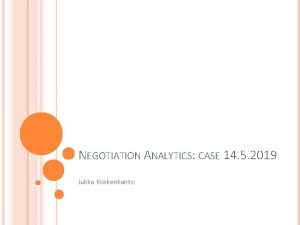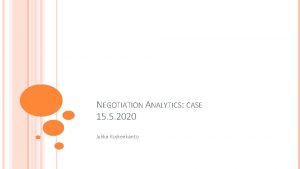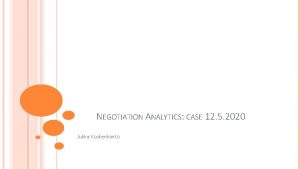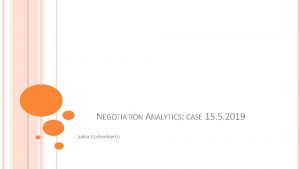NEGOTIATION ANALYTICS CASE 15 5 2018 Jukka Koskenkanto





- Slides: 5

NEGOTIATION ANALYTICS: CASE 15. 5. 2018 Jukka Koskenkanto

GENERAL INSTRUCTIONS FOR CASES Every case will be delivered and negotiated on lectures All case reports should be returned by 4. 6. to jyrki. wallenius@aalto. fi Each report should answer to the questions presented regarding the case Reports must be written per negotiation (combining the reports off all parties included) Grading will be based on case reports

LEARNING PROCESS • Know your theory • Read the instructions • Plan your negotiation strategy • Ask for more instructions Pre-case Negotiation • Implement your negotiation strategy • Modify the strategy only based on your reflections • Ask for more instructions • Analyze your negotiation • Try to understand why your strategy worked well or failed • Be brief Reporting

CASE: OIL PRICING Main learning objectives: � � � Groups of max 6 students (3+3) � � Two-party, multiple round, prisoner dilemma, pricing With whom to negotiate role of coalitions Alba (country) Batia (country) Schedule 10 -15 minutes to prepare with your team member Max 150 minutes for negotiations – based on detailed instructions given for all teams during the process � Case reporting instructions after negotiations are completed. � Remember to mark your attendance also (cannot be marked next week) � � Materials: � General instructions (1 copy per negotiating party)

REPORTING INSTRUCTIONS Maximum of 3 pages per party (6 per negotiation) + cover sheet List students (names + student numbers) of each party on cover sheet (+identify the party specific report with party name) Include the bids of each round from both parties in a combined table Answer to following questions 1. 2. 3. 4. 5. Include pre-case analysis of the negotiation to the report. (7 -elements or Pro. Act) If there were (or would have been) different opinions among your team how did you choose (or would you have chosen) your strategy? How did the market shocks affect the negotiations? When you had an opportunity to make an agreement about future bid(s) with the opposite party how did you try to ensure their commitment? Did it work? Why? What was the #1 learning in this case? Why?
